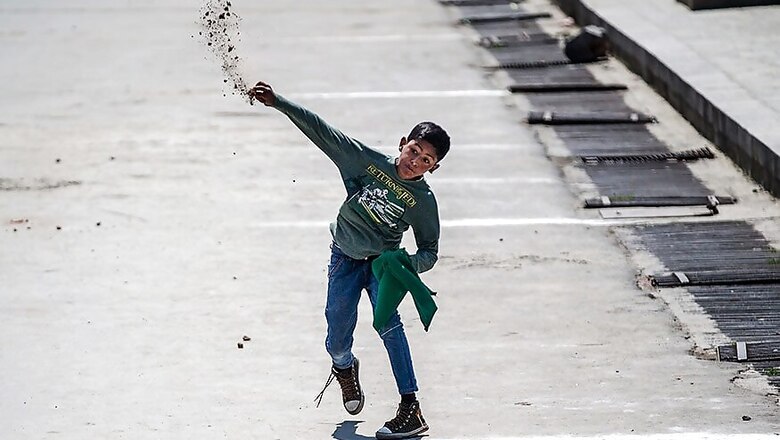
views
Violence as the new normal
On Wednesday, a Kashmiri army officer, who was attending cousin’s wedding, was abducted and shot dead by militants in Shopian. Lt Ummer Fayyaz was latest among over a hundred people, including policemen, politicians and civilians, killed this year in the Valley.
Thousands of students pelting stones. School girls out on the streets. CRPF jawans humiliated. Controversy over videos showing a Kashmiri man used as human shield by army convoy. Policemen instructed not to visit their homes. MLAs, including those of ruling party, hiding in Srinagar. Kashmiri Pandit camps attacked. Internet services suspended. Social networking websites and apps banned. Unprecedented events have happened in Kashmir over the past few months. People run as suspected militants offer a gun salute to Fayaz Ahmad, a suspected militant, who was killed in a retaliatory firing by police in a brief gun battle on Saturday evening in Kulgam district of Jammu & Kashmir, during his funeral in Qaimoh, May 7, 2017. (Photo: Reuters/Danish Ismail)OWAIS AHMED LONE was telling me about his close friends who became militants when we heard a loud bang. It distinctly sounded like bursts from an automatic rifle…Short bursts, one, two, three, and then it stopped. Lone's security guards, a dozen of them, scrambled to protect the People's Democratic Party's Shopian town president.
People run as suspected militants offer a gun salute to Fayaz Ahmad, a suspected militant, who was killed in a retaliatory firing by police in a brief gun battle on Saturday evening in Kulgam district of Jammu & Kashmir, during his funeral in Qaimoh, May 7, 2017. (Photo: Reuters/Danish Ismail)OWAIS AHMED LONE was telling me about his close friends who became militants when we heard a loud bang. It distinctly sounded like bursts from an automatic rifle…Short bursts, one, two, three, and then it stopped. Lone's security guards, a dozen of them, scrambled to protect the People's Democratic Party's Shopian town president.
It turned out to be a false alarm. A car had backfired.
Lone sat down in his chair, and the situation eased up. The guards settled back to their cups of tea. The streets of Shopian outside the restaurant where Lone met me were still empty.
Lone resumed the conversation and said he was running out of time to make a choice between the people he knew and the state that was turning increasingly aggressive. "Kashmir has come to a point where it has never been. Things have reached a maximum. I will have to make a choice very soon."
So can he, a mainstream politician, could think of picking up the gun? "Yes, why not, he asked back. "What else can you do when you feel helpless? When despite being part of the ruling party you can't save your friend from being detained, tortured and shot at," he said.The fact that a mainstream political leader can think of picking up the gun is an indicator of what a post-fear world looks like. A few days after I spoke to Lone, his colleague Abdul Gani Dar, PDP president of neighbouring Pulwama district, was shot dead by militants.A lot of people have joined militancy recently. In Shopian alone, where there were just 10 active militants a year ago, over 40 active militants are suspected by police forces.
This has been a trend in the South Kashmir and pockets of North Kashmir, especially since July last year when Burhan Wani, 22-year-old commander of Hizbul Mujahideen and a social media phenomenon, was killed in an encounter. A security personnel stands guard near a razor wire during curfew in Srinagar on Monday, August 15, 2016. (Photo: PTI/S Irfan)
A security personnel stands guard near a razor wire during curfew in Srinagar on Monday, August 15, 2016. (Photo: PTI/S Irfan)
Around 20 kms from the town of Shopian, in Nazneenpora, is the house of Farooq Ahmad Hurra. The 25-year-old was among the boys who joined militancy after the Burhan Wani encounter. He picked up gun in September last year and was killed in an encounter in March this year.
"We are proud of him. Better than dying every day is to die gloriously one day. More youths are going to pick up the gun and there is nothing to be ashamed about it," said his elder brother Altaf Hurra.
But gun-toting militants in Kashmir are very few now, say intelligence officials, and not as big a threat as they were in the ’90s.
Is the current unrest leading the valley towards the early '90s period of armed militancy? Maybe not.
According to sources in the state intelligence, there were close to 7,000 armed militants in the valley in 1996. In 1995 and 1996, around 3,000 militants were killed and nearly 8,000 arrested. The most number of militants were killed in 2001 - 2421.
At the moment, sources say, there are not even 300 armed militants in the valley. And guns are in extremely short supply. The parallel with '90s doesn't fit.
Quite unlike the '90s, the unrest in Kashmir today is being led exclusively by the youth. Neither mainstream parties nor Hurriyat, not even the terror outfits, seem to know which way these youth-led protests are headed next.
The unrest today is being led by those with jobs and those without jobs, by students and by aspiring cricketers, by farm labourers and landowners. Almost every other day hundreds and thousands of them are braving bullets, pellets, tear gas shells, PAVA (Pelargonic Acid Vanillyl Amide) shells, arrests, Public Safety Act and more just to throw stones on security forces.
"In '90s there was anger, emotions, sentiments," Hurriyat leader Mirwaiz Umar Farooq said, "In 2017, there is absolute hate."
Kashmir today is witnessing a sort of unrest that has never been seen before. Which is why no historical parallel can explain it.
As PDP co-founder and MP Muzzafar Baig told News18, "This is the darkest period in our history. From 1989 (when armed militancy began) it has been 27 years. Now, we have a new generation of people who have grown in a period of instability, militancy and terrorism… we may be headed to a very, very dangerous turn of events."
"EVERYBODY KNOWS there is no fineness or accuracy of suppression; if you hold down one thing, you hold down the adjoining" - The Adventures of Augie March, Saul Bellow.
There is no fixed pattern to it. The wave of youth-led protests listens and responds only to attacks on itself. Take, for instance, the extraordinary turn of events that protests in the valley took in April.
For the first time, students across the valley came out of their schools and colleges to protest against security forces. Hundreds pelted stones. Around 80 were hurt.
The trigger for this was police barging into Pulwama degree college and firing PAVA shells and pellet guns on students.
Three days earlier the students from this college had thrown stones at an army vehicle, which was coming in the college to hold a 'Sadhbhavna' function.
Then on April 15, the police backed by CRPF decided to move in and subdue the students.
"It was mayhem. We saw students throwing stones from the roof of buildings and police teams firing pellets and PAVA shells at them. It was unlike anything I have seen before. We brought 64 hurt students at the end of the carnage in 25 rounds, 40 of them were girls," said Tanveer Wani, an ambulance driver at Pulwama district hospital. A Kashmiri school girl throws stones at security forces during a protest in Srinagar on April 20, 2017. (AP Photo/Dar Yasin)
A Kashmiri school girl throws stones at security forces during a protest in Srinagar on April 20, 2017. (AP Photo/Dar Yasin)
What followed this incident was not just school students picking up stones across the valley and Pulwama youth swearing vengeance. After the campus opened on April 24, the students raised Pakistani flags in the campus and again clashed with the police.
Violent student protests in Pulwama continue to this day.
"The youth of Kashmir is getting mobilised.If they organise themselves into a political power, Hurriyat will be irrelevant and mainstream politicians are going to be irrelevant. If youths find a political platform, all of us will be redundant. This may be a very serious situation," said Muzzafar Baig.
I have seen, if only in infancy, the beginning of armed militancy in Kashmir, and have returned to Kashmir several times later to report on it. But politicians and policemen in Kashmir have never seemed as scared as they are now.
This is because riding this youth-led anger, terror outfits have attacked mainstream institutions in the valley several times in the past few weeks.In last one month, militants have killed 13 people, including five policemen, three political workers, four civilians and one army officer. Security personnel engaged in a gunbattle with a militant who was holed up in a house at village Durbugh in Chadoora area of central Kashmir's Budgam district on Tuesday. The militant and three civilians were killed in the operation. (Photo: PTI/S Irfan)
Security personnel engaged in a gunbattle with a militant who was holed up in a house at village Durbugh in Chadoora area of central Kashmir's Budgam district on Tuesday. The militant and three civilians were killed in the operation. (Photo: PTI/S Irfan)
Policemen and their families have been attacked more than 30 times in past few weeks.
So severe and frequent have been the attacks that the Director General of Police (DGP) for the first time had to issue advisory to policemen not to visit their homes for next few months in villages for fear of the militants.
The Director General of state police admitting to the unique nature of the threat to the lives of police officers and their families said, "Policemen from Jammu and Kashmir have been in the line of fire since the '90s. But this is first time that militants have misbehaved with our families."
Security forces are also believed to have lost their human-int capabilities severely in this prolonged season of unrest. Even after getting hit several times, the security forces have few successes to show since the summer of last year.
"There is an atmosphere of hatred against us. If we fire at protestors, the anger intensifies and more people come out to attack us. We have arrested thousands and slapped PSA on many. But it's not working. They have beaten us and attacked our families. Around 10-15 policemen have been killed in the past few months. Some of my colleagues have already shifted their families out from Kashmir to Jammu. Several more are looking to leave the force," said a senior police officer in the valley. Women contingent of Jammu and Kashmir police marching past during the 68th Republic Day parade at Bakshi Stadium in Srinagar on Thursday, January 26, 2017 (Photo: PTI/S Irfan)
Women contingent of Jammu and Kashmir police marching past during the 68th Republic Day parade at Bakshi Stadium in Srinagar on Thursday, January 26, 2017 (Photo: PTI/S Irfan)
A young person from Anantnag talked about how lines between enemies and their families were getting blurred. "There was a local boy who had joined militancy here. He was a friend. A member in his family fell ill and he came here to see them. Security people harassed his family and threatened them to no end. Finally they found the boy and killed him. Tell me, who brought in the family first? If they are getting to our families, why shouldn't we get to theirs?"
Militants have also, apart from killing 3 political workers in the past one month, barged into houses of least 20 other political workers. They've thrashed them and made them to apologise on video for being part of the mainstream.
Most of the militants doing these hit-jobs are believed to be trained foreigner mercenaries, who unlike the local youth don't posture with guns on camera.
Attacks led by these militants have triggered movement of almost all local PDP leaders and MLAs from South and some from North to Srinagar. Many PDP legislators are in hiding in the state's summer capital.
More than 70% of valley's population is under 35 years of age. And it is this section of society that one sees out in militant funerals, throwing stones at police, or picking up guns.
Siddiq Wahid, former vice chancellor, Islamic University of Science and Technology, Kashmir, has worked very closely with the valley's youth. He considers the involvement of the youth in the current turmoil unique for three reasons.
"First, it is home grown and has stayed that way. Second, it is a revolt of a generation after 1989, which is to say that overt and open resistance has taken root, and it is not shallow. Third, it is not a Srinagar-based urban uprising, as has almost always been the case, but one that has rural backing which now seems to dominate the discourse."
Wahid considers the involvement of the youth "a serious variable." A Kashmiri student throws a stone towards security forces (unseen) during a protest in Srinagar April 24, 2017. (Photo: Reuters/Danish Ismail)
A Kashmiri student throws a stone towards security forces (unseen) during a protest in Srinagar April 24, 2017. (Photo: Reuters/Danish Ismail)
"What it has brought about is a dangerous impasse. Youthful passion and the arrogance of state power that the security establishment deploys have brought about a zero-sum game. Both sides appear to have no appetite for talks, which spells blood."
There is little doubt about how youth is driving the unrest in the valley. But some are debating about what is driving this anger. Is it hopelessness fuelled by lack of jobs or something more than that?
Young political leaders from BJP, Hina Bhatt and Khalid Jahangir, feel that material aspirations are driving the youth.
"People of Kashmir are innocent, they just go with the flow. 90% of the youth don't even know what the issue is. There are over-educated youth without jobs who are driving this agitation and their percentage is also quite minimal," said Hina Bhatt.
Then what explains the massive attendance of youth in Burhan Wani's funeral? "Well, he was a cute looking guy… he was good in studies."
Khalid Jahangir claims to be the first Kashmiri Muslim to join BJP. The BJP spokesperson thinks a small number of people inspired by Wahabbist strains of Islam, living in paucity of avenues to express themselves, are leading the protests.
"There is Wahabbism that is driving a lot of youth to come out on roads. Things are very volatile in the valley, especially with the youth agitating. We need some time. We will gain confidence of youngsters by building cinemas and creating opportunities in sports," says Jahangir. Students pelt stones at security forces personnel during a clash in Srinagar on Monday, April 17, 2017 (Photo: PTI/S Irfan)
Students pelt stones at security forces personnel during a clash in Srinagar on Monday, April 17, 2017 (Photo: PTI/S Irfan)
Then there are those who find such arguments facetious. 31-year old Junaid Mattu, a political leader in National Conference, is among them.
"It has become harder and harder for young people in the valley to come into the mainstream. As a result of which you have separatism which is youth driven, big turn-out at militants' funerals and protest rallies. You now have an army of youth that is not apologetic. If the state wants to rob them, tie them to jeeps, well then people like me will shun mainstream; will never be apologists for the mainstream," said Mattu.
He added that one problem with the discourse on Kashmiri youth is how it is turned to their "aspirations and need for jobs". Referring to an encounter that took place in Chadoora, Budgam, on March 28, Mattu said, "The 22-year-old who got killed was a millionaire. The property in his own name alone was worth Rs 15 crore. This boy wanted to become a photographer. He had just bought a DSLR worth Rs 6 lakh. What do the people, who claim that militancy is being driven by illiterate and poor youth, even know about the situation on ground?"
The post-fear world of Kashmiri youth is perhaps a less reasonable world for others.
Huge protest rallies were taken out at several places in South Kashmir after the Burhan Wani encounter. Protesters attacked Kashmiri Pandit migrant camps at several places, Vessu near Qazigund and Hal in Shopian being among them.
These camps are inhabited by migrant Pandit families, who returned to Kashmir after the then Prime Minister Manmohan Singh announced a relief package in 2010. Fear lodged itself so deeply among migrant Pandits that those living in the Hal camp have still not returned to their homes. And only a fraction of the Pandits living in Vessu have come back.
"It felt like the old days. I couldn't move out of my house. Stones rained on our houses. The walls are still pockmarked. I have tried not to go out of the camp but when I need to, to buy groceries, I do so without talking much. I do not know how long we can survive like this," said an elderly Kashmiri Pandit man living in Vessu, who did not want to be identified. He had left Kashmir in 1990 exodus.
Another resident, who works as a teacher in Budgam, said, "We returned after several months. What could we do? We weren't being paid any salaries. We were living a hand to mouth existence in Jammu. Now that we have returned, we do go to our offices but don't ever discuss politics."
As a practice, no ceremonies - from birth, marriage to death - are performed in these camps to avoid infuriating the majority population. Pandit families quietly slip out to Jammu to celebrate or mourn.
Sanjay Tickoo, who is head of Kashmir-based Pandit organisation - Kashmiri Pandit Sangharsh Samiti - says Pandits have never faced this sort of hostility before. Kashmiri Pandits praying at Ram temple Barbarshah in Srinagar on the occasion of Ram Navami on Wednesday, April 5, 2017. (Photo: PTI/S Irfan)
Kashmiri Pandits praying at Ram temple Barbarshah in Srinagar on the occasion of Ram Navami on Wednesday, April 5, 2017. (Photo: PTI/S Irfan)

Among the people who have served in Kashmir, and observed the turmoil from up close, there are various theories about why Kashmir finds itself, where it does, today - 2008 Amarnath land row, 2010 mass protests and 2015 PDP-BJP alliance.
Some claim 2008 Amarnath land row to be the point from where situation in the valley slid downhill. "To understand the current turmoil, you have to go back to 2008. There was a period of peace in the valley. Support for separatists had dwindled. You had 2002, when for the first time Hurriyat had not boycotted elections. But suddenly the state government took a controversial decision, which it really never bothered to explain to the people. The state had gone in a state of complacency and lost touch with the ground," said a senior state police officer.
He added, "Even after the protests, the state never really apologised for what had happened. The separatists got their way and things never really improved from there."
Close to 60 people lost their lives in protests after state government decided to transfer 100 acres of land to Amarnath Shrine board.
For some, 2010 was an inflection point. Huge protests rocked the valley, a year after alleged fake rape and murder of two girls in Shopian. Security forces were for the first time face to face with stone pelters, and they decided to fire at them. Each funeral begot more anger and victims. Pellet guns were also introduced for the first time. A security personnel aims a pellet gun towards Kashmiri protestors during a clash in the Panzgam village of Kupwara, north of Srinagar, on April 27, 2017. (Photo: AFP)
A security personnel aims a pellet gun towards Kashmiri protestors during a clash in the Panzgam village of Kupwara, north of Srinagar, on April 27, 2017. (Photo: AFP)
An Intelligence Bureau official who served in Kashmir during the '90s said the security agencies had responded in a reactionary manner to the protests. "Amaranth Yatra. That was the turning point. We had choked the supply of guns in the valley. There were very few left. Militancy was at rock bottom. We had sanitised places like Kulgam that are burning today. It was in 2010 that for the first time we witnessed stone pelting on such a huge scale. This form of resistance was not common. In the end, I think our reaction was not appropriate. Way too many people died," he said.
In all 110 boys, some as young as 8, were shot dead by security forces.
But New Delhi this time responded by constituting a team of three interlocutors. Three interlocutors visited the valley, after getting mandate from the government, to enquire into what the people really wanted. Among the recommendations of the interlocutors, who met hundreds of people and went to each district of the valley, were rethinking about AFSPA (Armed Forces Special Powers Act) and Army Act, and addressing human rights issues.It has been six years since the interlocutors submitted their recommendations to the government. Barely any recommendation has been seriously considered. Radha Kumar, noted academician, who was one of the three interlocutors said, "Barely any of our recommendations - and certainly not the most important ones - were implemented. We said that there had to be protections for our security forces in conflict situations, but that AFSPA was not the best form, as the Supreme Court implied. We believed there was need to amend the Army Act incorporating both protection for our security forces in such situations and incorporating the SC guidelines."
It was back then that the committee had conveyed, that "if you don't approach the problem politically and with a reconciliation policy, you are exposing our security forces to violence," Kumar said.Instead of a conciliatory approach, the government was approaching Kashmir issue militarily, Kumar added, which was a big mistake.
"By doing so, they are making our security forces a scapegoat. The state government too has made their police forces a scapegoat - their MLAs and civil administration simply disappear when there is any violence, instead of reaching out to their constituencies or districts."
Others feel that it was early 2015, when Mufti allied with BJP in an attempt to bring "north pole and south pole" together, that caused heartburn in the valley and led to mass disaffection, whose symptom Burhan Wani's encounter in July 2016 was. Jammu and Kashmir Chief Minister Mehbooba Mufti (front-C) poses for a photograph alongside ministers from the People's Demoratic Party (PDP) and the Bhartiya Janta Party (BJP) after Mufti's swearing-in ceremony in Jammu on April 4, 2016. (Photo: AFP/Tauseef Mustafa)
Jammu and Kashmir Chief Minister Mehbooba Mufti (front-C) poses for a photograph alongside ministers from the People's Demoratic Party (PDP) and the Bhartiya Janta Party (BJP) after Mufti's swearing-in ceremony in Jammu on April 4, 2016. (Photo: AFP/Tauseef Mustafa)
Former Research and Analysis Wing (R&AW) chief, J&K IB chief and advisor to Atal Behari Vajpayee on Kashmir, AS Dulat feels that 2015 was a turning point. "That election actually didn't satisfy anybody… This alliance has just not worked. There was great hope that it would bring Jammu and Kashmir together. But it has taken them further apart. Has polarised them instead. North pole and south pole never met. That is the main reason for this. Then, last summer Burhan Wani was killed. And from there you saw youth coming out supporting and hiding militants."
A post-fear world also is an unpredictable world. A lot of people News18 spoke to, for this story, claimed to be in-charge of the events unfolding in Kashmir, but no one could predict which direction the youth-led unrest was heading to.
Hurriyat leader Mirwaiz Umar Farooq, without actually saying the words, hinted at Kashmir being headed to a civil war. "New Delhi is pushing us so hard that the Hurriyat leadership will be forced to take radical measures and declare that instead of being killed in intervals, we come out and occupy the streets."
I met a former LeT militant in Ganderbal who claimed that the momentum against the state would rise to "feverish pitch" very soon. The surrendered militant, perhaps not knowing that he was speaking to a Kashmiri Pandit, started the conversation by claiming how some militants had reached seventh heaven by killing pandits.
"The thing is there is support from all quarters for such a momentum. What's required is a spark," he said, talking about how encounter killing of a local Hizbul or LeT militant would see 2016 repeating itself.
While the year has not seen any big clash such as those witnessed in 2016, but more than 115 people have lost their lives already and the anger isn't any less.
The anger could manifest itself in unforeseen ways.
The State Election Commission (SEC) has cancelled the bypolls in South Kashmir's Anantnag seat after being denied the requisite security by New Delhi. But SEC cannot postpone the elections indefinitely.
Police officers, News18 spoke to, shuddered at the thought of managing elections in South Kashmir at this point of time.
The other big event is Amarnath Yatra. In two months from now, on June 29, the first batch of Amarnath Yatris will arrive in the valley. And within a week of that, the unrest in the valley, starting from Burhan Wani’s encounter on July 8, will complete a full year.
Though even last year the yatris were not harmed, no one knows how this year's yatra will play out. All that's required is a "spark", as the Lashkar militant said. A Kashmiri woman pours water on burning debris after a protest in Srinagar on September 30, 2016 (Photo: Reuters/Danish Ismail)
A Kashmiri woman pours water on burning debris after a protest in Srinagar on September 30, 2016 (Photo: Reuters/Danish Ismail)
On May 4, army carried out the "biggest combing operation" in past 15 years. More than 4000 personnel, including four battalions of Rashtriya Rifles (RR), eight companies of CRPF, and five platoons of J&K police, went through 20 villages in Shopian looking for terrorists.
But the combing operation, which came after back to back bank robberies and murders of policemen and bank guards in the area, achieved little.
The large group of personnel were attacked with stones by locals. During their return, the army officers were ambushed by militants who managed to escape. In the gunfire exchange, a local driver was killed, which further enraged locals against security forces.
On May 6, BJP president Amit Shah hinted during a speech in Agartala that the government's muscular policy in J&K will continue. The Modi government has already clarified before the Supreme Court that it would not hold any talks unless the violence stops in Jammu and Kashmir.
What is also not clear is how long this coalition, which is pulling itself in opposite directions, will survive. Every passing day the prospect of governor's rule in J&K is looking more real. If imposed such a step could be disastrous, political analysts say.
"Governor's rule is not the solution. It will undo several years of progress of democracy in Kashmir. Whatever PDP is, it needs to be supported by Delhi. Government should continue to be supported till its full term, 2020," said AS Dulat. A Kashmiri man paddles his boat at sunset on Dal Lake in Srinagar (Photo: Paula Bronstein/Getty Images)
A Kashmiri man paddles his boat at sunset on Dal Lake in Srinagar (Photo: Paula Bronstein/Getty Images)
In Albert Camus' 'The Plague' at the end of a long fight against the epidemic when the town is celebrating, the protagonist Rieux knows that only a temporary victory has been achieved. "He knew what those jubilant crowds did not know but could have learned from books: that the plague bacillus never dies or disappears for good; that it can lie dormant for years and years in furniture and linen-chests; that it bides its time in bedrooms, cellars, trunks, and bookshelves; and that perhaps the day would come when, for the bane and enlightenment of men, it would rouse up its rats again and send them forth to die in a happy city."(More News18 Immersives)












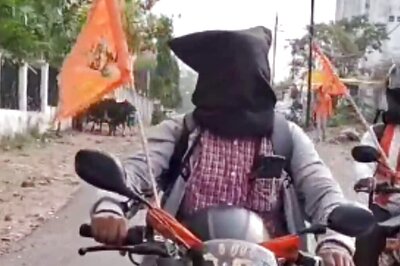
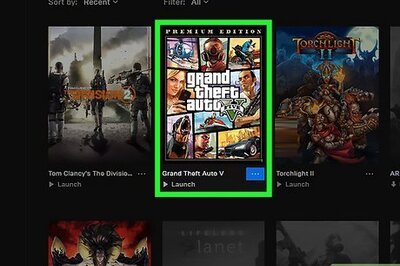




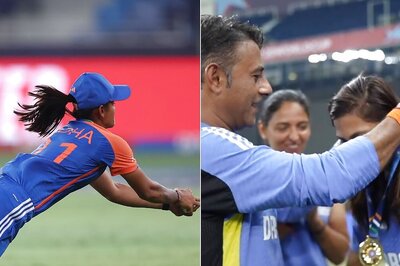
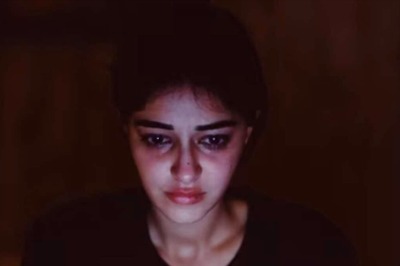
Comments
0 comment